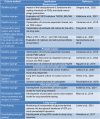Empowering personalized medicine: unleashing the potential of patient-derived explants in clinical practice
- PMID: 38343742
- PMCID: PMC10853634
- DOI: 10.17179/excli2023-6700
Empowering personalized medicine: unleashing the potential of patient-derived explants in clinical practice
Abstract
In recent decades, significant progress has been made in understanding the molecular characteristics of cancer and its microenvironment, leading to the development of life-saving treatments. However, patients often experience side effects from standard therapies, highlighting the need for personalized medicine. Personalized medicine aims to customize drug therapy and preventive care based on individual patients' specific requirements. The heterogeneity within tumors and among patients necessitates personalized medicine approaches. Patient-derived organoids (PDOs), xenografts (PDXs), and explants (PDEs) have emerged as valuable models for studying tumor behaviour and drug response. This paper aims to summarize the latest advancements in patient-derived explants, focusing on their potential utility in the clinic. Different methods for culturing PDEs, including the free-floating approach, the grid method, and sponge scaffolds, are discussed. These approaches provide opportunities for long-term viability, oxygen and nutrient supply, and maintenance of tissue integrity. Additionally, various solid tumor models using PDEs are highlighted, together with assays to study PDE viability, characteristics, and response to drug treatment.
Keywords: individual therapy; oncology; patient-derived explants; personalized medicine.
Copyright © 2024 Piwocka et al.
Conflict of interest statement
The authors declare that they have no conflict of interest.
Figures




Similar articles
-
Pancreatic cancer environment: from patient-derived models to single-cell omics.Mol Omics. 2024 May 7;20(4):220-233. doi: 10.1039/d3mo00250k. Mol Omics. 2024. PMID: 38414408 Review.
-
Patient-Derived Explants as a Precision Medicine Patient-Proximal Testing Platform Informing Cancer Management.Front Oncol. 2021 Dec 20;11:767697. doi: 10.3389/fonc.2021.767697. eCollection 2021. Front Oncol. 2021. PMID: 34988013 Free PMC article. Review.
-
Patient-derived organoid culture of gastric cancer for disease modeling and drug sensitivity testing.Biomed Pharmacother. 2023 Jul;163:114751. doi: 10.1016/j.biopha.2023.114751. Epub 2023 Apr 26. Biomed Pharmacother. 2023. PMID: 37105073
-
Patient-derived organoids of lung cancer based on organoids-on-a-chip: enhancing clinical and translational applications.Front Bioeng Biotechnol. 2023 May 26;11:1205157. doi: 10.3389/fbioe.2023.1205157. eCollection 2023. Front Bioeng Biotechnol. 2023. PMID: 37304140 Free PMC article. Review.
-
Development of Patient-Derived Gastric Cancer Organoids from Endoscopic Biopsies and Surgical Tissues.Ann Surg Oncol. 2018 Sep;25(9):2767-2775. doi: 10.1245/s10434-018-6662-8. Epub 2018 Jul 12. Ann Surg Oncol. 2018. PMID: 30003451
Cited by
-
Development of tetraculture spheroids as a versatile 3D model for personalized breast cancer research.Sci Rep. 2025 Jul 28;15(1):27449. doi: 10.1038/s41598-025-12556-9. Sci Rep. 2025. PMID: 40721466 Free PMC article.
References
-
- Bacero Bello A, Kim D, Kim D, Park H, Lee S-H. Engineering and functionalization of gelatin biomaterials: from cell culture to medical applications. Tissue Eng. 2020;26:164–80. - PubMed
LinkOut - more resources
Full Text Sources
